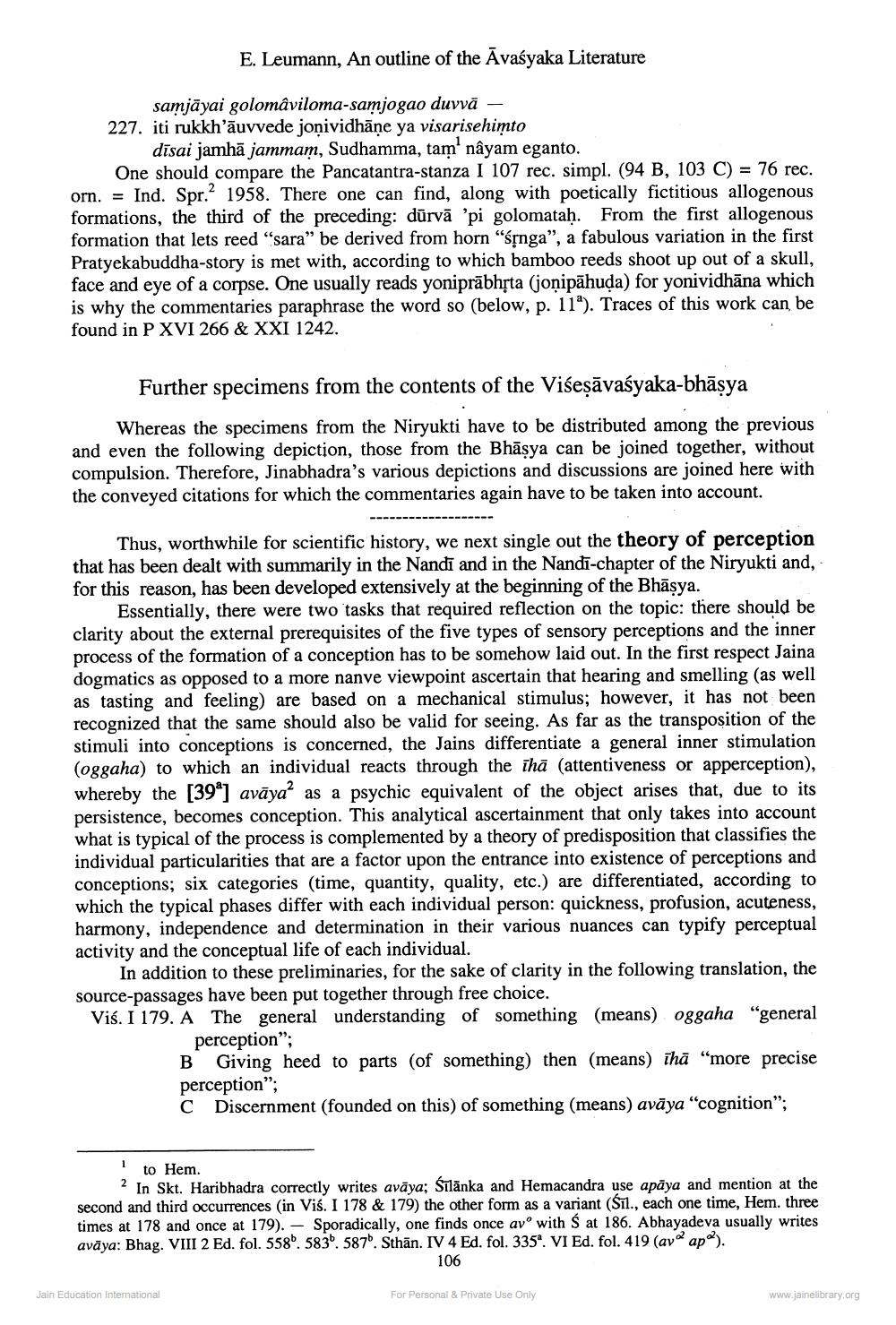________________
samjayai golomâviloma-samjogao duvvä - 227. iti rukkh'auvvede jonividhāṇe ya visarisehimto
E. Leumann, An outline of the Avaśyaka Literature
dīsai jamhā jammam, Sudhamma, tam1 nâyam eganto.
One should compare the Pancatantra-stanza I 107 rec. simpl. (94 B, 103 C) = 76 rec. orn. Ind. Spr.2 1958. There one can find, along with poetically fictitious allogenous formations, the third of the preceding: dūrva 'pi golomataḥ. From the first allogenous formation that lets reed "sara" be derived from horn "śṛnga", a fabulous variation in the first Pratyekabuddha-story is met with, according to which bamboo reeds shoot up out of a skull, face and eye of a corpse. One usually reads yoniprabhṛta (jonipahuḍa) for yonividhana which is why the commentaries paraphrase the word so (below, p. 11). Traces of this work can be found in P XVI 266 & XXI 1242.
Further specimens from the contents of the Viseṣāvaśyaka-bhāṣya
Whereas the specimens from the Niryukti have to be distributed among the previous and even the following depiction, those from the Bhāṣya can be joined together, without compulsion. Therefore, Jinabhadra's various depictions and discussions are joined here with the conveyed citations for which the commentaries again have to be taken into account.
Thus, worthwhile for scientific history, we next single out the theory of perception that has been dealt with summarily in the Nandi and in the Nandi-chapter of the Niryukti and, for this reason, has been developed extensively at the beginning of the Bhāṣya.
Essentially, there were two tasks that required reflection on the topic: there should be clarity about the external prerequisites of the five types of sensory perceptions and the inner process of the formation of a conception has to be somehow laid out. In the first respect Jaina dogmatics as opposed to a more nanve viewpoint ascertain that hearing and smelling (as well as tasting and feeling) are based on a mechanical stimulus; however, it has not been recognized that the same should also be valid for seeing. As far as the transposition of the stimuli into conceptions is concerned, the Jains differentiate a general inner stimulation (oggaha) to which an individual reacts through the thā (attentiveness or apperception), whereby the [39] avāya2 as a psychic equivalent of the object arises that, due to its persistence, becomes conception. This analytical ascertainment that only takes into account what is typical of the process is complemented by a theory of predisposition that classifies the individual particularities that are a factor upon the entrance into existence of perceptions and conceptions; six categories (time, quantity, quality, etc.) are differentiated, according to which the typical phases differ with each individual person: quickness, profusion, acuteness, harmony, independence and determination in their various nuances can typify perceptual activity and the conceptual life of each individual.
In addition to these preliminaries, for the sake of clarity in the following translation, the source-passages have been put together through free choice.
Viś. I 179. A The general understanding of something (means) oggaha "general
Jain Education International
perception";
B Giving heed to parts (of something) then (means) ihā "more precise perception";
Discernment (founded on this) of something (means) avaya "cognition";
C
1 to Hem.
2 In Skt. Haribhadra correctly writes avaya; Śīlānka and Hemacandra use apaya and mention at the second and third occurrences (in Viś. I 178 & 179) the other form as a variant (Sil., each one time, Hem. three times at 178 and once at 179). Sporadically, one finds once av° with S at 186. Abhayadeva usually writes avāya: Bhag. VIII 2 Ed. fol. 558b. 583. 587. Sthan. IV 4 Ed. fol. 335. VI Ed. fol. 419 (av ap).
106
For Personal & Private Use Only
www.jainelibrary.org




